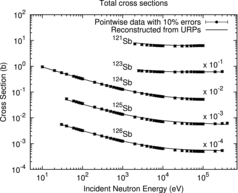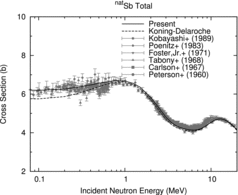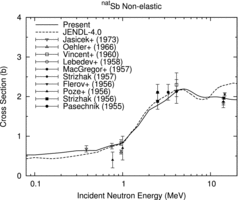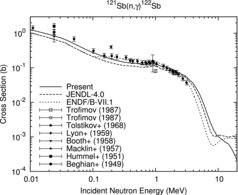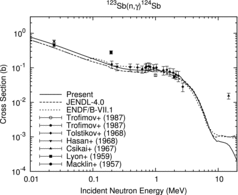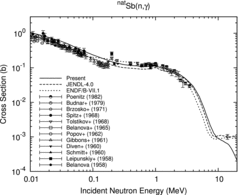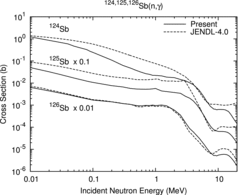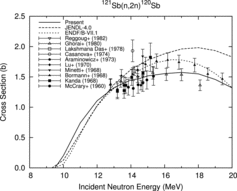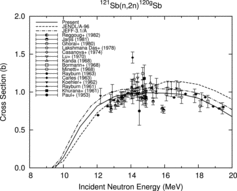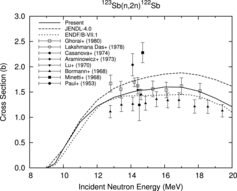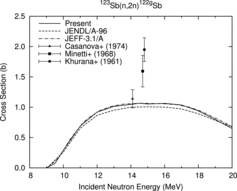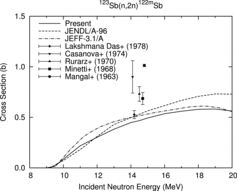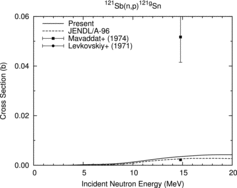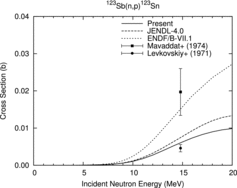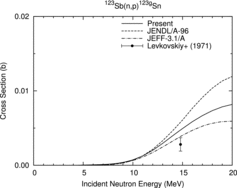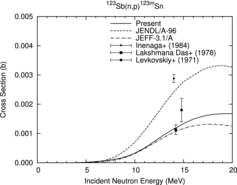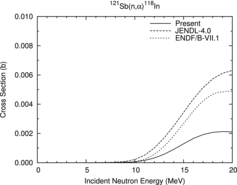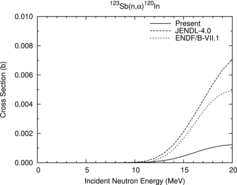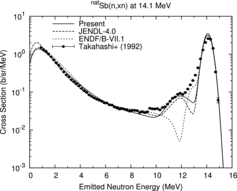Abstract
Neutron nuclear data on 121,123,124,125,126Sb have been evaluated for the next version of JENDL general purpose file in the energy region from 10− 5 eV to 20 MeV. In the low-energy region, the latest resolved resonance parameters were taken into account for 121, 123Sb. The thermal capture cross sections of 125, 126Sb, for which no measurements exist, were determined by using a simplified formula. The statistical model was applied to calculate the cross sections above the resolved resonance region. In the calculations, coupled-channel optical model parameters were used for the interaction between neutrons and odd-mass targets. Preequilibrium and direct-reaction processes were considered in addition to the compound process. The present evaluation is consistent with available experimental data. The evaluated data are compiled into an ENDF-formatted data file.
1. Introduction
The fourth version of the Japanese Evaluated Nuclear Data Library (JENDL-4.0 [Citation1]) was released in May 2010. In this library, 215 nuclides are regarded as fission products in the region from Z = 30 to 68. Although the resolved resonance parameters (RRPs) were examined by reviewing experimental data for all of those nuclides, the fast neutron region above resolved resonances was re-evaluated for about 170 nuclides due to time limit. Hence, the fast-neutron cross sections for the rest of the fission-product nuclides may need improvements for the next version of JENDL general purpose file. Antimony isotopes are classified into such nuclides. Moreover, neutron-induced activation cross sections of Sb isotopes are important [Citation2] for the decommissioning of light-water reactors. Therefore, it is required to re-examine the cross sections of Sb.
The data of 121,123,124Sb were evaluated for JENDL-2 [Citation3] in 1984. For JENDL-3.1 [Citation4], the 125Sb data were newly evaluated in 1990. After that, the 121,123Sb data were revised by considering the evaluations for JENDL/F-99 [Citation5] in 1994, and the revised data were adopted by JENDL-3.2 [Citation6]. The 121,123,124,125Sb data mentioned above were essentially carried over to JENDL-3.3 [Citation7] and JENDL-4.0 [Citation1], whereas a new evaluation of 126Sb was performed for JENDL-4.0. In the above evaluations except for 126Sb, the statistical-model code CASTHY [Citation8] was used to calculate the total, elastic and inelastic scattering, and capture cross sections, while the cross sections for the competing reactions such as (n, 2n) and (n, p) were obtained from the codes PEGASUS [Citation9] or GNASH [Citation10]. The direct inelastic scattering was considered for 121,123Sb by using the distorted-wave Born approximation (DWBA). However, gamma-ray production data were not compiled into the library except for 126Sb.
The present work was undertaken to improve the evaluated data on 121,123,124,125,126Sb by considering the latest knowledge on experimental and theoretical nuclear physics. Evaluated are the total, elastic and inelastic scattering, (n, γ), (n, p), (n, d), (n, t), (n, 3He), (n, α), (n, np), (n, nd), (n, nα), (n, 2n), (n, 3n) reaction cross sections, the angular distributions of emitted neutrons and charged-particles, and the energy distributions of emitted particles and γ-rays in the incident-neutron energy region from 10− 5 eV to 20 MeV. The Q-values of the reactions were calculated from the 2003 version of the mass table (AME2003) obtained by Audi et al. [Citation11] and are listed in , together with isotopic abundances [Citation12]. The RRPs of 121,123Sb were modified by considering the latest measurements. The thermal capture cross sections of 125,126Sb were determined by using a simplified formula. The unresolved resonance parameters (URPs) were obtained by fitting to the calculated total and (n, γ) cross sections.
Table 1. Isotopic abundances and reaction Q-values of antimony isotopes.
This paper presents how the evaluation was performed. Section 2 deals with the resonance region. In Section 3, the computational methods and procedures above the resonance region are described. Comparisons of the evaluated results with available experimental data and evaluated data are made in Section 4. Finally, Section 5 summarizes the conclusion.
2. Resonance region
The resolved and unresolved resonance regions are given in for each target nucleus. In the resolved resonance regions of 121,123Sb, we took account of the parameters of the p-wave resonances obtained by Matsuda et al. [Citation13] from the transmission measurements. In their analysis, the total spin J and the radiation width Γγ are unknown. The spin value was estimated from the probability distribution of J using the JCONV code [Citation14]. The Γγ values were taken from the average values adopted in JENDL-4.0, i.e., 89 meV and 98 meV for 121Sb and 123Sb, respectively.
Table 2. Resolved and unresolved resonance regions.
Concerning thermal cross sections, if no measurements are available, the scattering cross sections can be given by the potential scattering, i.e.,
(1) where R is the scattering radius, which can be estimated from nuclear model calculations in the higher energy region. However, there is not a useful method to determine the radiative capture cross section, although the 1/v behavior is normally assumed in the low energy region. Blatt and Weisskopf [Citation15] made rough estimates of unknown capture cross sections. The present work followed the same method. Namely, the capture cross section at a thermal energy
is expressed by
(2) where k is the wave number of the relative motion in the incident channel, K the wave number of the incident neutron in a compound nucleus, ⟨Γγ0⟩ the average total radiative width for s-wave neutrons, and D0 the average level spacing for s-wave neutrons. The derivation of Equation (Equation2
(2) ) is given in the Appendix. The unknown thermal capture cross sections of 125,126Sb are calculated theoretically, and they are listed in together with the recommendations of Mughabghab [Citation16]. Although the estimates are rough, the calculated values of 121,123Sb are in fair agreement with those of Mughabghab based on available measurements. The experimental value of 124Sb, which is recommended by Mughabghab, is a maximum value, as mentioned by the authors [Citation17]. Therefore, the calculated thermal capture cross sections of 125,126Sb were adopted in the present work.
Table 3. Calculated thermal capture cross sections.
The ASREP code [Citation18] was used to determine the URPs by fitting to the total and capture cross sections evaluated in the energy region above 10 eV. It should be noted that the URPs obtained are used only for self-shielding calculations, since the pointwise cross sections are given in the evaluated data files. The total cross sections reconstructed from the URPs presently obtained are compared in with the evaluated pointwise cross sections which are described in the next section. In the parameter fitting, 10% errors of the pointwise cross sections were assumed. It is found from the figure that the reconstructed cross sections reproduce the pointwise cross sections very well.
3. Computational methods and procedures above resonance region
3.1. Nuclear models
The POD code [Citation19] was used for calculating the neutron-induced reaction cross sections of Sb isotopes. The code is based on the spherical optical model, the one-component exciton preequilibrium model, the DWBA, and the multistep statistical model. In order to simulate the direct and semidirect effects on the capture reaction, the preequilibrium capture was considered by using the γ-ray emission rate derived by Akkermans and Gruppelaar [Citation20]. The original POD code was modified to allow for options of γ-ray strength functions, i.e., generalized, extended generalized, and modified Lorentzians [Citation21,Citation22] (GLO, EGLO and MLO, respectively) for E1 radiation, in addition to the standard Lorentzian (SLO).
The POD code is not capable of calculating direct reaction cross sections and transmission coefficients by the coupled-channel method. These two kinds of data are supplied to POD by a separate coupled-channel code if the use of the coupled-channel method is preferable. In the present work, the coupled-channel optical model code OPTMAN [Citation23] supplied those values to the POD code.
3.2. Parameter determination
3.2.1. Optical-model potentials
We employed the global neutron optical-model parameters obtained by Kunieda et al. [Citation24] using the coupled-channel method based on the rigid-rotator model (RRM) [Citation25] with slight modifications. The real volume depth V0R, imaginary surface depth , and imaginary volume depth
were changed to –37.3 MeV, 10.5 MeV, and 27.0 MeV, respectively, so that the calculations could reproduce measured total cross sections. The exact functional forms of the potentials are given in Ref. Citation24. The coupling schemes and deformation parameters are listed in . As for 124,126Sb, the parameters of Kunieda et al. were used as the spherical optical model potentials. The calculated total cross section of elemental Sb is illustrated in , together with experimental data and the spherical optical model calculations using the parameters of Koning and Delaroche [Citation26]. It is found from the figure that the present calculations are in better agreement with the experimental data than the calculations using the parameters of Koning and Delaroche especially in the energy region below 1 MeV. shows a comparison of the presently calculated nonelastic cross sections of the elemental Sb with measured data and JENDL-4.0. The calculations are consistent with the measured data. In the energy region above 10 MeV, the JENDL-4.0 evaluation is larger than the present and measured values, which indicates that some reaction cross sections of 121,123Sb in JENDL-4.0 could be overestimated in the high energy region.
Table 4. Coupling schemes used in the interaction between neutrons and targets.
Built-in values in POD were used for charged-particle optical-model parameters, i.e., the values of Koning and Delaroche [Citation26] for protons, those of Lohr and Haeberli [Citation27] for deuterons, those of Becchetti and Greenlees [Citation28] for tritons and 3He, and those of Lemos [Citation29] potentials modified by Arthur and Young [Citation30] for α-particles. The values of Lohr-Haeberli and Becchetti-Greenlees potentials were actually taken from the compilation of Perey and Perey [Citation31].
3.2.2. Discrete levels and level density
In the present calculation, it was necessary to input the discrete levels and level density parameters for 25 nuclei, i.e., 119−127Sb, 119−126Sn and 117−124In. The discrete levels were taken from the reference input parameter library RIPL-3 [Citation32].
Concerning the level density, the composite formula of Gilbert and Cameron [Citation33] was used in the present work. In the region of low excitation energy E, the level density is described by the constant temperature formula ρT, namely,
(3) On the other hand, the a parameter, which characterizes the Fermi-gas part of level density ρF, is defined as
(4) where
is the shell correction energy and γ a damping factor. The energy U is expressed by E and the pairing energy Δ, i.e., U = E − Δ. In the above equations, the values of a(*),
, γ, and Δ were taken from the work of Mengoni and Nakajima [Citation34,Citation35]. The two parameters T and E0 were determined so as to connect ρF and ρT smoothly at an appropriate matching energy Em. The parameters used in this work are listed in for individual nuclei, together with the energies of the highest discrete levels
.
Table 5. Level density parameters for each nucleus.
3.2.3. Gamma-ray transition
The MLO form was used for E1 radiation in the present work, since it is recommended to use in RIPL-3 [Citation32]. The giant resonance parameters for E1 were taken from RIPL-3, where the parameters were obtained by a fit of theoretical photo-absorption cross sections to experimental data. Unless the parameters are available for particular nucleus in RIPL-3, one can use the systematics given in Ref. Citation32. The resonance energy and width parameters for M1 and E2 are also obtained from another systematics [Citation36] and given by
(5)
(6)
(7)
(8) The symbol A stands for the mass number of a nucleus. The contributions of M1 and E2 relative to E1 were estimated [Citation10] such as
(9)
(10) As for compound nuclei 122,124Sb, the functions are normalized so as to reproduce measured capture cross sections of the corresponding target nuclei around several tens of keV. The s-wave γ-ray strength functions Sγ0 obtained are compared in with the values recommended by Mughabghab [Citation16] and those used in the JENDL-4.0 evaluations. Normalization factors for the other nuclei were obtained by using the calculated average level spacing D0 for s-wave neutrons and the thermodynamical formula for the average total radiative width <Γγ0> for s-wave neutrons. The latter quantity is expressed [Citation37] by
(11) where Sn is the separation energy of a neutron from a compound nucleus. It should be noted that Sn and Δ are given in the unit of MeV and a in MeV− 1. The quantities D0 and<Γγ0> lead to
(12)
Table 6. Gamma-ray strength functions for s-wave neutrons in units of 10−4.
3.2.4. Preequilibrium parameters
For preequilibrium capture, SLO-shaped photon absorption cross sections are required [Citation20] to calculate the γ-ray emission rate. The peak cross section, resonance energy and resonance width are calculated from the systematics [Citation32]. If the experimentally determined parameters are available in RIPL-3, the systematics are replaced with them. The single-particle state density g, which is required to describe the preequilibrium state density for a residual nucleus, is set to A/13 MeV−1 for all nuclei but 121,123−126Sn. Comparing with measured proton emission data, the g values were adjusted for these residual nuclei, i.e., 7.0 MeV−1. There remain three kinds of normalization parameters for preequilibrium particle emission in the POD code: K, which determines the absolute square of the average matrix element for the residual two-body interaction and the scale factors for a pickup reaction and α-particle knockout, and
. The values used are listed in .
Table 7. Preequilibrium parameters used in the present work.
4. Comparison with experimental and other evaluated data in fast neutron energy region
The presently evaluated data are compared with exp- erimental and other evaluated data. The experimental data are taken from the EXFOR database [Citation38], which is available in the international data centers such as the OECD/NEA Data Bank. As for the general-purpose nuclear data, there are three major libraries, i.e., JENDL-4.0 [Citation1], ENDF/B-VII.1 [Citation39], and JEFF-3.1.2 [Citation40]. However, they are not independent of each other. The 121,123Sb data of JEFF-3.1.2 were taken from JENDL-3.3, which means that the two isotopic data of JEFF-3.1.2 are identical to those of JENDL-4.0. On the other hand, the 124,125Sb data of ENDF/B-VII.1 were taken from JENDL-3.3. Identical evaluated data are not drawn in the following figures. It should be noted that the general-purpose libraries do not contain any partial activation cross sections leading to the ground or isomeric state. The activation cross-section files JENDL/A-96 [Citation41] and JEFF-3.1/A [Citation42] are used for comparison with such activation data. We do not discuss most of the reactions where experimental data are unavailable, since it is difficult to judge whether the present evaluation is reasonable without measurements.
The radiative capture cross sections are shown in –. The present evaluation well reproduces the measured data of 121,123Sb, while the JENDL-4.0 evaluation is lower than the measured data below several MeV. Concerning the elemental data, the measured data of Gibbons et al. [Citation43] are systematically smaller than those of Spitz et al. [Citation44], as seen in . Both experiments employed the time of flight method, although the former one normalized the data to the shell transmission measurements obtained by Schmitt and Cook [Citation45]. The JENDL-4.0 and ENDF/B-VII.1 evaluations obviously laid weight on the measurements of Gibbons et al. On the other hand, Macklin et al. [Citation46] measured the capture cross sections of 121,123Sb at 24 keV by using the activation method, and the sum weighted with the isotopic abundance is 739 ± 61 mb. This value is almost consistent with the value of 677 ± 94 mb at 22 keV measured by Spitz et al. within experimental uncertainties. The present evaluation placed emphasis on the consistency between the isotopic and elemental data. As a result, the cross sections obtained are larger than the JENDL-4.0 and ENDF/B-VII.1 evaluations below 100 keV. The capture cross sections of 124,125Sb are systemically smaller than JENDL-4.0, as seen in , since smaller γ-ray strength function values were used. As for 126Sb, the same value as that for JENDL-4.0 was employed, yielding almost the same cross sections as those for JENDL-4.0.
The (n, 2n) reaction cross sections of 121,123Sb are illustrated in –. The present evaluation is in good agreement with the data measured by Ghorai et al. [Citation47]. The total (n, 2n) reaction cross sections of JENDL-4.0 (the sum of ground and isomeric state production) are obviously larger the present results above 12 MeV, which is consistent with the fact that the JENDL-4.0 evaluation overestimates the nonelastic cross sections in the high energy region. Concerning 121Sb(n, 2n)120mSb, the JENDL/A-96 data are smaller than the present and JEFF-3.1/A evaluations in the entire energy region. Most of the measured partial cross sections of 123Sb are larger than all evaluations, although the presently evaluated total (n, 2n) cross sections of 123Sb agree with the data of Ghorai et al. [Citation47], as mentioned above.
– show the (n, p) reaction cross sections. The 121Sb(n, p)121gSn data of JEFF-3.1/A are not drawn in , since they are identical to those of JENDL/A-96. It is difficult to judge which evaluation is the best because of few measurements for each reaction.
The (n, α) cross sections of 121,123Sb are shown in and . There exist no measured data for these reactions. The present evaluation is obviously smaller than JENDL-4.0 and ENDF/B-VII.1, since the default values were used for the preequilibrium parameters and
.
The neutron emission spectra of elemental antimony are illustrated in at an incident energy of 14.1 MeV. As in the case [Citation48] of Br, we assumed a pseudo-resonance at an excitation energy of 2.3 MeV for 121,123Sb, which can substitute for the missing collective enhancement phenomenologically. The cross section for the resonance was calculated by DWBA using the neutron potential parameters mentioned in Section 3 with β3 = 0.237, and it was smeared by a normal distribution with a standard deviation of 0.6 MeV. This treatment modifies the shapes of preequilibrium spectra. It is found from the figure that the present evaluation is in good agreement with the data measured by Takahashi et al. [Citation49]. The ENDF/B-VII.1 evaluation obviously underestimates the experiment around 12 MeV.
5. Concluding remarks
The neutron nuclear data of 121,123,124,125,126Sb were evaluated in the energy region from 10−5 eV to 20 MeV. The RRPs of 121,123Sb were modified by taking account of the latest measurements. The thermal capture cross sections of 125,126Sb were determined by using a simplified formula. The URPs were obtained for self-shielding calculations by fitting to total and capture cross sections mainly calculated from the nuclear models.
Above the resolved resonance region, the present evaluation is mainly based on the statistical model using the POD code. The neutron transmission coefficients were obtained by the coupled-channel method for odd-mass targets, together with the total cross sections, the shape elastic scattering cross sections and the direct-reaction components of the inelastic scattering cross sections. The model parameters used in the calculations were determined more accurately than the earlier works. On the whole, the presently evaluated cross sections are in good agreement with available experimental data, and better than the existing evaluated data. Moreover, the gamma-ray production data, which were missing in JENDL-4.0 except for 126Sb, were newly evaluated. The evaluated data are compiled into an ENDF-formatted data file for the next release of JENDL general purpose file.
Acknowledgements
The author would like to thank the members of the Nuclear Data Center, Japan Atomic Energy Agency, for their helpful comments on this work.
References
- Shibata K, Iwamoto O, Nakagawa T, Iwamoto N, Ichihara A, Kunieda S, Chiba S, Furutaka K, Otuka N, Ohsawa T, Murata T, Matsunobu H, Zukeran A, Kamada S, Katakura J. JENDL-4.0: A new library for nuclear science and engineering. J Nucl Sci Technol. 2011; 48: 1–30.
- IAEA Safety Standards Series. Application of the concepts of exclusion, exemption and clearance (No. RS-G-1.7). Vienna: International Atomic Energy Agency; 2004.
- Kikuchi Y, Nakagawa T, Asami T, Kawai M, Matsunobu H, Kanda Y. Second version of Japanese evaluated nuclear data library (JENDL-2). J Nucl Sci Technol. 1985; 22: 593–603.
- Asami T, Iijima S, Igarasi S, Ihara H, Kawai M, Kikuchi Y, Komuro Y, Shibata K, Takano H, Takeda T, Nakagawa T, Nakazawa M, Hasegawa A, Maekawa H, Mizumoto M, Yoshida T. Japanese evaluated nuclear data library version 3, JENDL-3. J At Energy Soc Jpn. 1989;31:1190–1217 [ in Japanese].
- Chiba S, Fukahori T, Shibata K, Yu BS, Kosako K, Yamamuro N. JENDL fusion file 99. J Nucl Sci Technol. 2002; 39: 187–194.
- Nakagawa T, Shibata K, Chiba S, Fukahori T, Nakajima Y, Kikuchi Y, Kawano T, Kanda Y, Ohsawa T, Matsunobu H, Kawai M, Zukeran A, Watanabe T, Igarasi S, Kosako K, Asami T. Japanese evaluated nuclear data library version 3 revision-2: JENDL-3.2. J Nucl Sci Technol. 1995; 32: 1259–1271.
- Shibata K, Kawano T, Nakagawa T, Iwamoto O, Katakura J, Fukahori T, Chiba S, Hasegawa A, Murata T, Matsunobu H, Ohsawa T, Nakajima Y, Yoshida T, Zukeran A, Kawai M, Baba M, Ishikawa M, Asami T, Watanabe T, Watanabe Y, Igashira M, Yamamuro N, Kitazawa H, Yamano N, Takano H. Japanese evaluated nuclear data library version 3 revision-3: JENDL-3.3. J Nucl Sci Technol. 2002; 39: 1125–1136.
- Igarasi S, Fukahori T. Program CASTHY – statistical model calculation for neutron cross sections and gamma ray spectrum – (JAERI 1321). Tokai: Japan Atomic Energy Research Institute; 1991.
- Nakagawa T, Iijima S, Sugi T, Nishigori T. PEGASUS: a preequilibrium and multi-step evaporation code for neutron cross section calculation (JAERI-Data/Code 99-031). Tokai: Japan Atomic Energy Research Institute; 1999.
- Young PG, Arthur ED, Chadwick MB. Comprehensive nuclear model calculations: introduction to the theory and use of the GNASH code (LA-12343-MS). Los Alamos: Los Alamos National Laboratory; 1992.
- Audi G, Wapstra AH, Thibault C. The AME2003 atomic mass evaluation (II). Tables, graphs and references. Nucl Phys A. 2003; 729: 337–676.
- Berglund M, Wieser ME. Isotopic compositions of the elements 2009 (IUPAC technical report). Pure Appl Chem. 2011; 83: 397–410.
- Matsuda Y, Bowman JD, Crawford BE, Delheij PPJ, Haseyama T, Knudsen JN, Lowie LY, Masaike A, Masuda Y, Mitchell GE, Penttilä SI, Postma H, Roberson NR, Seestrom SJ, Sharapov EI, Stephenson SL, Yen Y-F, Yuan WV. Parity violation in neutron resonances of antimony and iodine. Phys Rev C. 2001; 64: 015501-1–015501-7.
- Nakagawa T, Kikuchi Y, Fukahori T. Auxiliary programs for resonance parameter storage and retrieval system REPSTOR (JAERI-Data/Code 99-030). Tokai: Japan Atomic Energy Research Institute; 1999 [ in Japanese].
- Blatt JM, Weisskopf VF. Theoretical nuclear physics. New York: John Wiley & Sons; 1952.
- Mughabghab SF. Atlas of neutron resonances, resonance parameters and thermal cross sections Z=1–100. Amsterdam: Elsevier; 2006.
- Nishimura K, Ogawa S, Tsutiya T. Reactor neutron capture cross section of 60.3-day 124Sb. J Nucl Sci Technol. 1979; 16: 546–552.
- Kikuchi Y, Nakagawa T, Nakajima Y. ASREP: a computer program for automatic search of unresolved resonance parameters (JAERI-Data/Code 99-025). Tokai: Japan Atomic Energy Research Institute; 1999 [ in Japanese].
- Ichihara A, Iwamoto O, Chiba S, Kunieda S, Shibata K. Program POD; a computer code to calculate cross sections for neutron-induced nuclear reactions (JAEA-Data/Code 2007-012). Tokai: Japan Atomic Energy Agency; 2007.
- Akkermans JM, Gruppelaar H. Analysis of continuum gamma-ray emission in precompound-decay reactions. Phys Lett B. 1985; 157: 95–100.
- Kopecky J, Uhl M, Chrien RE. Radiative strength in the compound nucleus 157Gd. Phys Rev C. 1993; 47: 312–322.
- Plujko VA, Ezhov SN, Kavatsyuk MO, Grebenyuk AA, Yermolenko RV. Testing and improvements of gamma-ray strength functions for nuclear model calculations. J Nucl Sci Technol. 2002;2(Suppl):811–814.
- Soukhovitski ESh, Chiba S, Iwamoto O, Shibata K, Fukahori T, Morogovskij GB. Programs of OPTMAN and SHEMMAN version 8 (2004) (JAERI-Data/Code 2005-002). Tokai: Japan Atomic Energy Research Institute; 2005.
- Kunieda S, Chiba S, Shibata K, Ichihara A, Sukhovitskiĩ ESh. Coupled-channels optical model analyses of nucleon-induced reactions for medium and heavy nuclei in the energy region from 1 keV to 200 MeV. J Nucl Sci Technol. 2007; 44: 838–852.
- Tamura T. Analyses of the scattering of nuclear particles by collective nuclei in terms of the coupled-channel calculation. Rev Mod Phys. 1965; 37: 679–708.
- Koning AJ, Delaroche JP. Local and global nucleon optical models from 1 keV to 200 MeV. Nucl Phys A. 2003; 713: 231–310.
- Lohr JM, Haeberli W. Elastic scattering of 9–13 MeV vector polarized deuterons. Nucl Phys A. 1974; 232: 381–397.
- Becchetti FD, Greenlees GW. A global set of 3He and triton optical-model potentials for A > 40, E < 40 MeV. In: Barshall HH, Haeberli W, editors. Proceedings of the Third International Symposium on Polarization Phenomena in Nuclear Reactions; 1970 August 31 – September 4; Madison. Wisconsin: University of Wisconsin Press; 1971. p. 682–683.
- Lemos OF. Diffusion élastique de particules alpha de 21 à 29.6 MeV sur des noyaux de la region Ti-Zn [dissertation] (Orsay report, Series A., No. 136). Université de Paris-sud; 1972.
- Arthur ED, Young PG. Evaluated neutron-induced cross sections for 54, 56Fe to 40 MeV (LA-8626-MS). Los Alamos: Los Alamos National Laboratory; 1980.
- Perey CM, Perey FG. Compilation of phenomenological optical-model parameters 1954–1975. Atom Data Nucl Data Tables. 1976; 17: 1–101.
- Capote R, Herman M, Obložinský P, Young PG, Goriely S, Belgaya T, Ignatyuk AV, Koning AJ, Hilaire S, Plujko VA, Avrigeanu M, Bersillon O, Chadwick M, Fukahori T, Ge Z, Han Y, Kailas S, Kopecky J, Maslov VM, Reffo G, Sin M, Soukhovistskii ESh, Talou P. RIPL – reference input parameter library for calculations of nuclear reactions and nuclear data evaluations. Nucl Data Sheets. 2009; 110: 3107–3214.
- Gilbert A, Cameron AGW. A composite nuclear-level density formula with shell corrections. Can J Phys. 1965; 43: 1446–1496.
- Mengoni A, Nakajima Y. Fermi-gas model parametrization of nuclear level density. J Nucl Sci Technol. 1994; 31: 151–162.
- Mengoni A, Nakajima Y. HERMES: a personal-computer program for calculation of the Fermi-gas model parameters of nuclear level density (JAERI-M 93-177). Tokai: Japan Atomic Energy Research Institute; 1993.
- Kopecky J. Gamma-ray strength functions (IAEA-TECDOC-1034). Vienna: International Atomic Energy Agency; 1998. p. 97–111.
- Benzi V, Maino G, Menapace E, Ventura A. BCS level density calculations and consistent estimate of radiative widths by means of a thermodynamic model. In: Coceva C, Panini GC, editors. Proceedings of Specialists’ Meeting on Neutron Cross Sections of Fission Product Nuclei; 1979 December 12–14; Bologna. Bologna, Italy: Comitato Nazionale Energia Nucleare; 1979. p. 215–230.
- Schwerer O, editor. EXFOR formats description for users (EXFOR basics) (IAEA-NDS-206). Vienna: International Atomic Energy Agency; 2008.
- Chadwick MB, Herman M, Obložinský P, Dunn M, Danon Y, Kahler AC, Smith DL, Pritychenko B, Arbanas G, Arcilla R, Brewer R, Brown DA, Capote R, Carlson AD, Cho YS, Derrien H, Guber K, Hale GM, Hoblit S, Holloway S, Johnson TD, Kawano T, Kiedrowski BC, Kim H, Kunieda S, Larson NM, Leal L, Lestone JP, Little RC, McCutchan EA, MacFarlane RE, Macinnes M, Mattoon CM, McKnight RD, Mughabghab SF, Nobre GPA, Palmiotti G, Palumbo A, Pigni MT, Pronyaev VG, Sayer RO, Sonzogni AA, Summers NC, Talou P, Thompson IJ, Trkov A, Vogt RL, van der Marck SC, Wallner A, White MC, Wiadra D, Young PG. ENDF/B-VII.1 nuclear data for science and technology: cross sections, covariances, fission product yields and decay data. Nucl Data Sheets. 2011; 112: 2887–2996.
- OECD Nuclear Energy Agency Data Bank. Available from http://www.oecd-nea.org/dbforms/data/eva/evatapes/jeff_31/JEFF312/
- Nakajima Y. JENDL activation cross section file. In: Igashira M, Nakagawa T, editors. Proceedings of the 1990 Symposium on Nuclear Data; 1990 November 29–30; Tokai; JAERI-M 91-032. Tokai: Japan Atomic Energy Research Institute; 1991. p. 43–57.
- Koning A, Forrest R, Kellett M, Mills R, Henriksson H, Rugama Y, editors,. The JEFF-3.1 nuclear data library (JEFF Report 21). Paris: OECD Nuclear Energy Agency; 2006.
- Gibbons JH, Macklin RL, Miller PD, Neiler JH. Average radiative capture cross sections for 7- to 170-keV neutrons. Phys Rev. 1961; 122: 182–201.
- Spitz LM, Barnard E, Brooks FD. Neutron capture cross sections of Cr, Mn, Ni, Nb, Ag, In, Sb and Au in the 8 to 120 keV region. Nucl Phys A. 1968; 121: 655–672.
- Schmitt HW, Cook CW. Absolute neutron absorption cross sections for Sb-Be photoneutrons. Nucl Phys. 1960; 20: 202–219.
- Macklin RL, Lazar NH, Lyon WS. Neutron activation cross sections with Sb-Be neutrons. Phys Rev. 1957; 107: 504–508.
- Ghorai SK, Gaiser JE, Alford WL. Activation cross sections for the (n,2n) reactions on 121, 123Sb between 12.8 and 18.1 MeV. J Phys G Nucl Phys. 1980; 6: 393–399.
- Shibata K, Ichihara A, Kunieda S. Evaluation of neutron nuclear data on bromine and krypton isotopes for JENDL-4.0. J Nucl Sci Technol. 2011; 48: 429–439.
- Takahashi A, Gotoh M, Sasaki Y, Sugimoto H, Yamanaka K, Kanazawa H, Maekawa F. Measurement of double differential neutron emission cross sections at 14.1 MeV for Ti, Mo, Sn and Sb (OKTAV-A-92-01). Osaka: Osaka University; 1992.
- Bohr A, Mottelson BR. Nuclear structure, volume I, single-particle motion. New York (NY): W.A. Benjamin Inc.; 1969.
Appendix. Thermal capture cross section
Considering only s-wave, the radiative capture cross section at thermal energy is written as
(A1) where ΓJn, ΓJγ, ΓJ, and EJ are the neutron width, the radiative width, the total width, and the resonance energy for a total spin J, respectively. The symbol k denotes the wave number of the relative motion in the incident channel, and it is related to the following equations:
(A2)
(A3) where mn, mt, and μ stand for the masses of a neutron and a target and the reduced mass, respectively. The statistical factor gJ for a target spin I is calculated from
(A4)
Using the s-wave level spacing of the compound nucleus D0, the neutron width is approximated [Citation15] by
(A5) with the wave number of the incident neutron inside the nuclear surface given by
(A6) where Sn is the separation energy of a neutron from the compound nucleus, and EF the Fermi energy. The Fermi energy is given [Citation50] by
(A7)
It is assumed that the thermal cross section is practically determined by a single resonance near E0. Substituting Equation (EquationA5(A5) ) into Equation (EquationA1
(A1) ), one can obtain
(A8) The quantity |E0 − EJ| is expected to be the order of D0. Thus, we may put |E0 − EJ| ≡ D0/2ζ, where ζ ≥ 1. Assuming that |E0 − EJ| ≫ ΓJ/2, we obtain
(A9)
The statistical factor gJ is 1.0 for I = 0, while gJ is approximately equal to 1/2 if I ≠ 0. Furthermore, setting ζ2 = 1 and replacing ΓJγ with the average s-wave radiative width ⟨Γγ0⟩, Equation (EquationA9(A9) ) becomes
(A10)
(A11)

